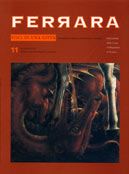Seated on a very high chair, Jesus has amazed and annoyed the doctors of Jewish Law; one of these, defeated by the Divine arguments, is lifting up the commentary with an irate gesture prior to hurling it to the ground; on the other side of the scene, the Virgin Mary is comforting Joseph, after three days spent wandering Jerusalem in search of the lost Child, now found again. Despite its advanced state of disrepair, there is no doubt that this rare piece is the work of Vitale da Bologna as more than one clue points to the work of this imaginative artist.
The activity of Vitale outside his native city is amply documented: he executed commissions for the chapter of Ferrara cathedral (ca. 1340), and for the Bishop of that city (1344), and, a few years after he made the paintings in Copparo, he decorated the apsidal semi-dome of the Abbey of Pomposa (1351), while a few years before that (1347-49) he had gone as far as Udine, where he worked for Cardinal Bertrand de Saint Genies.
In the apse of Santa Maria di Savonuzzo there are still some fragments of a fresco, the faces of the characters and some drapery, alongside areas in which a sort of cartoon, rather like a sinopite, can be seen; Vitale worked over these outlines to complete the painting that is now lost, perhaps without troubling to consider the technical consistency of the painting and the consequent perishability of the materials applied.
It follows that the image of the irate doctor has the face frescoed in smooth, shadowy tones while part of the body betrays the rapidity of Vitale's preparatory sketches, immediate as thought, lightning fast and brilliant as may be seen in the Flagellation in Udine Cathedral (1348). The inscription on the plaque mounted on the façade of the little church commemorates the establishment of the building in 1344, by order of Giovanni da Saletta; the frescoes inside, therefore, cannot precede that date, but, at least as far as concerns Vitale's fragments in the apse, were executed a very few years after.
The remaining frescoes with the Annunciation and the Adoration of the Magi, which adorn the triumphal arch and the rear part of the right hand wall, also appear to have been painted not long afterwards.
The blonde Archangel provides the best clue as to the character of the artist at work here. The graphic dimension is somewhat understated in comparison to Vitale's work, while the theme is polished and refined; the vivacious profile, the elegant limpness of the gestures and the fussy precision of the neck and shoulder line reveal the traits of a personality that was as new as it was rare in the Trecento, precisely for the remarkable desire to attain a high quality of representation. What remains of the Virgin of the Annunciation leaves one with a feeling of admiration admixed with sorrow at the loss of such a demonstration of style.
Another jolt of controlled imagination needs to be applied in observing the Adoration of the Magi on the right hand wall of the church; a landscape of green clay unfolds at the feet of the figures, trying to unify the narration of a scene that, if not ruined, is certainly sorely tried by the recesses of the windows and the door that right from the beginning represented interruptions in the stretch of wall that could be usefully painted.
On one side of the window, the Virgin sits on a throne with a solid-looking pedestal in pink marble: on the other side, the Magi are depicted in various positions. Among their number is the horseman in red, with his purse and his long, elegant sleeves hanging down.
Along the margins of this richly decorated invention there runs a strip featuring a combination of mosaic work in a mixture of marbles and tiles engraved with vegetable and animated motifs, in the ancient manner: one of the numerous upsurges of Gothic painting but also proof of this painter's close ties with Vitale, whose own repertoire of decorative fresco techniques contains many common elements.
While the paintings discussed so far are part of a single iconographic project, which certainly called for a sequence and a consequent narrative capacity, the frescoed panels near the entrance to the church represent a response to a different requirement.
These are "votive", since it appears legitimate to think in terms of a private commission, and they respond to the iconic function of the representation: the holy image lends itself, unmoving, to the worship of the faithful. Here the iconological tradition has drawn to the icon certain narrative elements calculated to aid recognition of the figure: so, Christopher is depicted in the act of ferrying the Child, and the Madonna of Humility seems like the Mary of the manger, but more isolated.
The popular and unrefined style of the Madonna of the Milk is next to the panel with the Madonna of Humility and Saint Christopher, executed by a painter with a more complex cultural background, and not immune to the appeal of Tommaso da Modena or of his follower, Serafino. In this case the unknown painter was the latest of the artists active in Santa Maria di Savonuzzo and was perhaps at work in this charming little church in the last decade of the 13th century.



